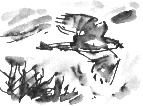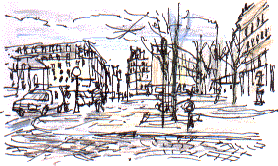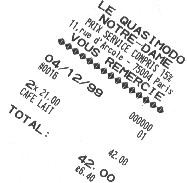 |
PennySunday, 2nd December 2001, West Yorkshire |
![]()
![]()
![]()
![]()
![]()
![]() This Month
Rocks
History
Workshop
Links
Home Page
This Month
Rocks
History
Workshop
Links
Home Page
![]()
 SPARROWHAWKS feature a lot in this diary, but it still gives me a thrill to see one. This morning a large grey-brown sparrowhawk, probably a female, zooms over the wall 10 feet in front of me near the bridge. They're a raptor that comes right into our world, often hunting at head height. By comparison the Kestrel seems rather remote, hovering over the grass verges by the motorway, keeping its distance.
SPARROWHAWKS feature a lot in this diary, but it still gives me a thrill to see one. This morning a large grey-brown sparrowhawk, probably a female, zooms over the wall 10 feet in front of me near the bridge. They're a raptor that comes right into our world, often hunting at head height. By comparison the Kestrel seems rather remote, hovering over the grass verges by the motorway, keeping its distance.It's my lucky day; I spot a coin on the path. A penny and not worth stopping for? - no, it's a pound coin, which I still feel has enough value to merit picking up. It would still buy you a cup of tea on the train.
 Standardised, sensible Euros are replacing national coinage all over Europe. I'll miss the pleasure of paying for a crêpe in francs, a cappuccino in lira or wild garlic soup in Austrian shillings.
Standardised, sensible Euros are replacing national coinage all over Europe. I'll miss the pleasure of paying for a crêpe in francs, a cappuccino in lira or wild garlic soup in Austrian shillings.The penny was originally one twelfth of a shilling (and there were 20 of those to the pound, it seemed to make perfect sense at the time). It was first minted as a silver coin by the Anglo-Saxons. Quantities of them ended up in Denmark as Danegeld, a tax which started as a Viking extortion racket but which was levied by the English monarch long after the threat subsided. I've heard the name attributed to Penda of Mercia, the last pagan king in England.
 It's still a link with the past, even in its diminutive 'new penny' form, but back in the 1960s, when I was at school it was a direct link with our history. You'd often come across Edward VII or Queen Victoria on the 'heads' side. 'Bun pennies' were the oldest. The design, of the young Victoria with her hair in a bun, was usually worn almost flat. My Grandma used to collect them in a jam jar for a church appeal, which, in those days, was probably for a missionary fund.
It's still a link with the past, even in its diminutive 'new penny' form, but back in the 1960s, when I was at school it was a direct link with our history. You'd often come across Edward VII or Queen Victoria on the 'heads' side. 'Bun pennies' were the oldest. The design, of the young Victoria with her hair in a bun, was usually worn almost flat. My Grandma used to collect them in a jam jar for a church appeal, which, in those days, was probably for a missionary fund.
![]()
Richard Bell,
wildlife illustrator
E-mail; 'richard@willowisland.co.uk'
![]() Next page
Previous page
This day last year
This month
Nature Diary
Home Page
Next page
Previous page
This day last year
This month
Nature Diary
Home Page
![]()